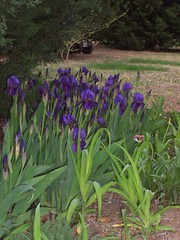Here's another iris picture.
Friday, May 20, 2005
Early iris
I'm learning more about posting photos to my blog. I'll start by sharing this picture of some early purple iris that bloomed in my yard in early April.
Tuesday, May 10, 2005
I am writing a series of articles describing how to use blogs in the classroom or school setting. While I was exploring a variety of blogging services, I came across this site, Weblogg-ed. You will want to check out the list of educational blogs the author has collected.
Where can you find my articles later this year? Check out Technology Pathfinder for Teachers at The Master Teacher website. The articles will start in July and should continue through November or December!
Where can you find my articles later this year? Check out Technology Pathfinder for Teachers at The Master Teacher website. The articles will start in July and should continue through November or December!
Friday, March 11, 2005
Wednesday, January 12, 2005
Are you a national board certified teacher? If not, have you checked out the National Board Website? Here's an article about an independent research project that has been conducted that shows the effectiveness of National Board Teachers.
I have a lot more to tell you about National Board certification - but that's enough for today. Read the article and think......
I have a lot more to tell you about National Board certification - but that's enough for today. Read the article and think......
Friday, January 07, 2005
The National Technology Plan was unveiled today. This site provides details of the plan, as well as a link to download a pdf file of the complete report entitled, Toward a New Golden Age in American Education.
Highlights from the Seven Major Actions Steps and Recommendations
Highlights from the Seven Major Actions Steps and Recommendations
- Strengthen leadership - Produce tech savvy leaders.
- Consider innovative budgeting - Consider leasing programs.
- Improve teacher training - Provide preservice preparation, online learning, and increased resources.
- Support e-learning and virtual schools - Provide e-learning access for every student.
- Encourage broadband access - Ensure access, reliability, and support.
- Move toward digital content - Guarantee ubiquitous access to computers and connectivity for each student.
Do your students spend hours instant messaging their friends? According to the Pew Report, approximately 13 million teens are intense users of this communication tool. Would you like to address the issue so that your students understand when IM lingo is appropriate and when it is not?
Check out this lesson from Read Write Think.org entitled Audience, Purpose, and Language Use in Electronic Messages. Designed for students in grades 6-8, the lesson discusses the appropriate use of Internet abbreviations. There's even a great handout that provides you with a list of commonly used abbreviations.
This lesson on What’s the Difference? Beginning Writers Compare E-mail with Letter Writing helps students in grades K-2 explore the difference between e-mail and snail mail letters.
Write Right Back: Recognizing Readers’ Needs and Expectations for E-mail Replies helps K-2 students understand the functions of reply and reply all to email messages.
These links were included in today's issue of NCTE Inbox. Inbox is a wonderful enewsletter that is chock full of great ideas, links to articles, and discussions of current issues. Subscribe today.
CU L8R!!!
Check out this lesson from Read Write Think.org entitled Audience, Purpose, and Language Use in Electronic Messages. Designed for students in grades 6-8, the lesson discusses the appropriate use of Internet abbreviations. There's even a great handout that provides you with a list of commonly used abbreviations.
This lesson on What’s the Difference? Beginning Writers Compare E-mail with Letter Writing helps students in grades K-2 explore the difference between e-mail and snail mail letters.
Write Right Back: Recognizing Readers’ Needs and Expectations for E-mail Replies helps K-2 students understand the functions of reply and reply all to email messages.
These links were included in today's issue of NCTE Inbox. Inbox is a wonderful enewsletter that is chock full of great ideas, links to articles, and discussions of current issues. Subscribe today.
CU L8R!!!
Thursday, January 06, 2005
The NetAlert CyberSafe Schools site has several resources and links for teaching students about internet safety and cyberethics.
You can download pdf files of secondary and primary wall charts, quick reference guides, and a Teacher Guide to Internet Safety.
Two of the links include Cyberethics for Teachers and Cyberethics for Kids.
You will want to look at the Ten Commandments of Cyber Ethics at the Cyber Citizen site. In addition, the site provides a number of link designed Just For Kids.
You can download pdf files of secondary and primary wall charts, quick reference guides, and a Teacher Guide to Internet Safety.
Two of the links include Cyberethics for Teachers and Cyberethics for Kids.
You will want to look at the Ten Commandments of Cyber Ethics at the Cyber Citizen site. In addition, the site provides a number of link designed Just For Kids.
Subscribe to:
Posts (Atom)

